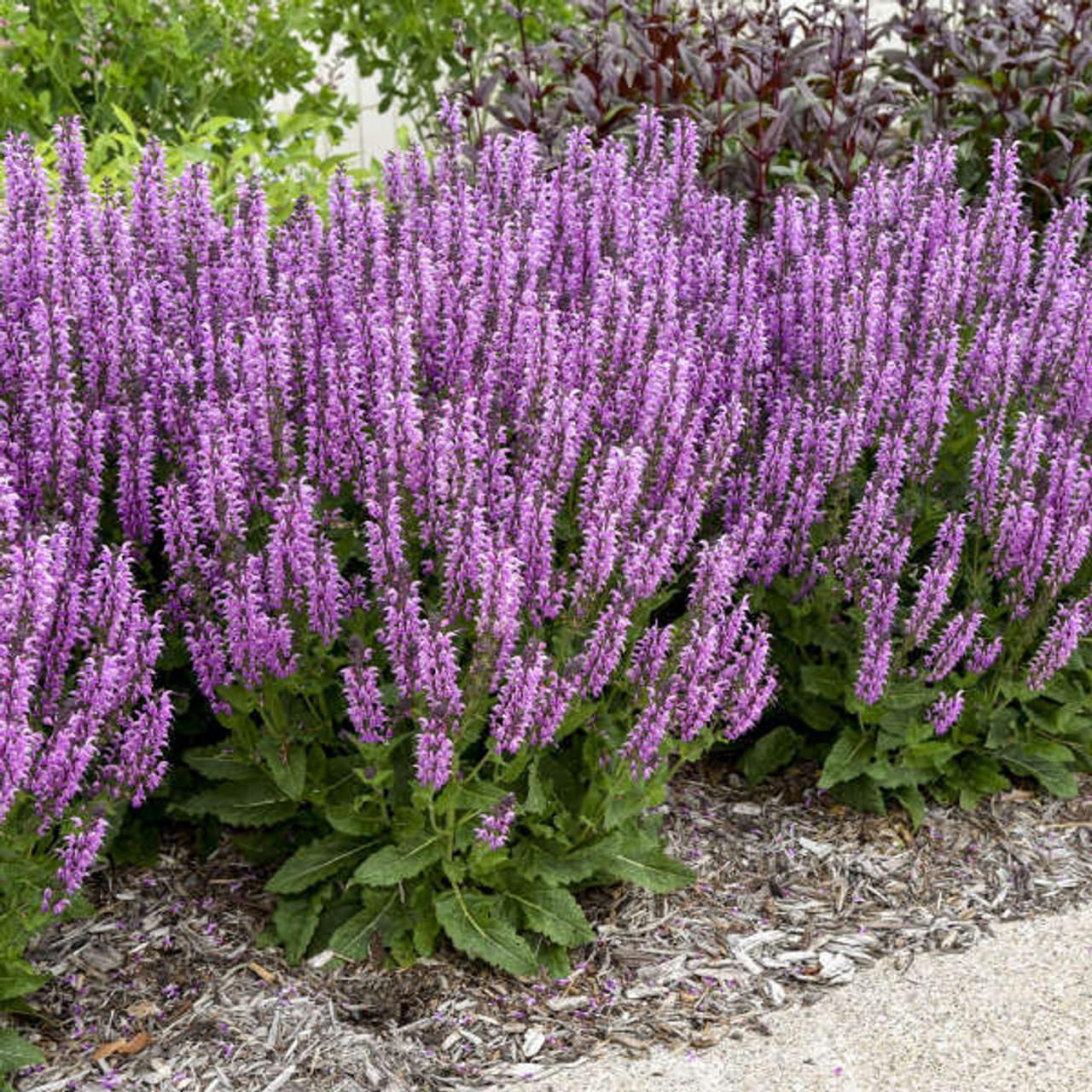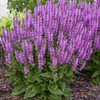Product Description
Salvia 'Back to the Fuchsia' PP32920 (25) Bare Root Plants
Proven Winners® COLOR SPIRES® Collection
Common Name: Perennial Salvia
The darkest pink of the COLOR SPIRES® Collection, this variety produces fuchsia pink flowers on dark charcoal stems. Flowers are produced prolifically above a canopy of dark green leaves. A cross between S. nemorosa and S. pratensis. Will rebloom if sheered back.
Salvia is a staple item for every sunny garden. It asks little more than sunshine and a little drink every once in a while in return for producing a bountiful mass of colorful flower spires from late spring into early summer. It forms a uniform, rounded clump of aromatic, rugose green foliage that looks nice all season long and is not enjoyed by rabbits or deer.
Salvia is easy to grow in almost any climate. Though it is drought tolerant, it will bloom better with regular watering. Deadheading encourages a longer bloom time. If plants get leggy during the season, cut them all the way back to the newly developed foliage. If cut back, plants may rebloom in fall but often the flowers are fewer and smaller.
Height: 22-24 Inches
Spread: 22-24 Inches
Hardiness Zones: 3,4,5,6,7,8
Flower Color: Pink shades
Foliage Color: Green shades
Full Sun to Part Shade
Low to Average Water Needs
Average Soil Quality
Bloomtime: Late Spring - Early Summer
Attracts Butterflies and Hummingbirds
Bee Friendly
Deer and Rabbit Resistant
Seasonal Interest: Dried Seed Heads
Growth Rate: Medium
Border Plant, Cut Flower, Cut Foliage, Dried Flower, Easy To Grow, Fragrant Flowers, Fragrant Foliage, Mass Planting, Salt Tolerant
Salvia 'Back to the Fuchsia' is a vibrant and long-blooming perennial that brings a burst of bright pink color to gardens. It is a popular choice for its eye-catching flowers, attractive foliage, and ability to attract pollinators. Here is a closer look at what makes it special:
Appearance:
- Flowers: 'Back to the Fuchsia' produces tall, slender spikes of vibrant fuchsia-pink flowers that bloom profusely from early summer to fall. The flower spikes rise above the foliage, creating a beautiful display of color.
- Foliage: The plant has aromatic, deep green foliage that forms a neat and mounded habit. The leaves release a pleasant scent when brushed or crushed, adding another sensory dimension to the garden.
Growing Conditions:
- Light: Thrives in full sun (at least 6 hours of direct sunlight) for optimal flowering and a more robust growth habit.
- Soil: Adaptable to a wide range of well-drained soils. Amending heavy clay or sandy soils with organic matter improves drainage and overall plant performance.
- Water: Prefers consistent moisture, especially during the establishment period. Once established, it has moderate drought tolerance.
Characteristics:
- Mature Size: Reaches a height of 22-24 inches with a similar spread, forming a compact and mounded clump.
- Hardiness Zones: Suitable for USDA hardiness zones 3-8, making it a versatile choice for various climates.
- Bloom Time: Blooms continuously from early summer to fall, providing a long-lasting display of color. Deadheading spent flowers can encourage additional blooms and maintain a tidy appearance.
Why it is Popular:
- Vibrant Color: The bright fuchsia-pink flowers of 'Back to the Fuchsia' add a cheerful and bold touch to the garden, creating a stunning focal point.
- Long Blooming Season: Provides continuous color throughout the summer and into fall, ensuring a vibrant display for an extended period.
- Compact Habit: Perfect for smaller gardens or containers where space is limited, as well as for mass plantings to create a stunning border.
- Low Maintenance: 'Back to the Fuchsia' is relatively low-maintenance, requiring minimal care once established.
- Attracts Pollinators: The flowers attract hummingbirds, butterflies, and other beneficial pollinators to the garden.
- Fragrant Foliage: The aromatic foliage adds another sensory dimension to the garden and deters deer and rabbits.
Uses:
- Borders: Adds vertical interest and vibrant color to garden borders.
- Cottage Gardens: Its informal and colorful blooms blend seamlessly into cottage garden settings.
- Containers: Suitable for container gardening, where its compact habit can be displayed on patios or balconies.
- Cut Flowers: The long-lasting flowers can be used in fresh arrangements.
Additional Information:
- 'Back to the Fuchsia' is part of the Color Spires® series of Salvia, known for their vibrant colors and long blooming periods.
- Deadheading spent flowers not only promotes reblooming but also prevents self-seeding.
- Cutting back the plant after the first flush of blooms can encourage a second flush of flowers later in the season.
- Dividing clumps every few years helps maintain plant vigor and prevents overcrowding.
Overall, Salvia 'Back to the Fuchsia' is a fantastic choice for gardeners seeking a vibrant, low-maintenance, and pollinator-friendly perennial. Its adaptability, long bloom time, and attractive foliage make it a valuable addition to any garden, bringing joy and beauty throughout the summer and fall months.
Other Details
The most important part of the plant is its root system. Healthy roots are the foundation of a healthy, vibrant plant. The type of plug container used is based on the specific needs of the plants. Perennials offered as bare root traditionally perform better when planted as bare root.Planted in a specialized mix, potted plants have well established root systems. Top growth stage will vary depending on the current life cycle and time of year when shipped. In Winter and early Spring dormant plants may be shipped. Dormant plants may be planted right away, even before the last frost date.
Most bare root varieties are field grown for at least one season, though Hemerocallis and Hosta are grown for two seasons. The bulk of the soil is removed during the harvesting process and the tops of most varieties are trimmed back to the crown. They are graded, packed in shredded aspen or sphagnum moss and stored in freezers until ready to be shipped.
See our Container Sizes and Bare Root Perennials pages for more information.
Plant information and care is provided in the Overview section, Plant Genus Page and general information is provided in the Planting Care & Guides. Additional questions can be asked on each Plant page.
Plant Spacing: Using the maximum mature spread or width of a plant to guide spacing, ensures space to grow to full size. To fill an area sooner, plant them closer together. Just remember, future thinning or transplanting may be needed.
Water: Keep a close eye on newly planted perennials, especially throughout the first growing year. Most early plant loss is due to too much or too little water!













